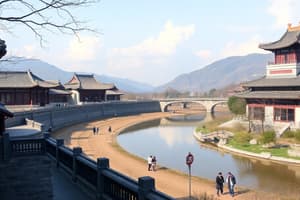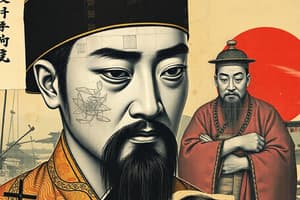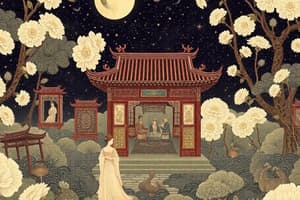Podcast
Questions and Answers
What major infrastructure projects were undertaken by Yangdi during the Sui Dynasty?
What major infrastructure projects were undertaken by Yangdi during the Sui Dynasty?
Yangdi repaired the Great Wall and constructed the Great Canal.
How did the Tang Dynasty restore the central government in China?
How did the Tang Dynasty restore the central government in China?
The Tang Dynasty restored a strong central government by reinstating civil service exams for selecting officials.
Who was the only woman to rule China on her own and what contributions did she make?
Who was the only woman to rule China on her own and what contributions did she make?
Empress Wu was the only woman to rule China on her own, and she strengthened the military and added more officials.
Explain the impact of the Battle of Talas on the Tang Dynasty.
Explain the impact of the Battle of Talas on the Tang Dynasty.
What circumstances led to the end of the Sui Dynasty?
What circumstances led to the end of the Sui Dynasty?
Describe the territorial expansion achieved by the Tang rulers.
Describe the territorial expansion achieved by the Tang rulers.
What led to the economic prosperity of the Song Dynasty?
What led to the economic prosperity of the Song Dynasty?
How did Buddhism get introduced to China and in what historical context?
How did Buddhism get introduced to China and in what historical context?
How did early Tang rulers approach the practice of Buddhism in China?
How did early Tang rulers approach the practice of Buddhism in China?
What reasons did some Chinese people have for opposing Buddhism during the Tang dynasty?
What reasons did some Chinese people have for opposing Buddhism during the Tang dynasty?
What was the response of the Tang government to Buddhism in their efforts to uphold Confucian traditions?
What was the response of the Tang government to Buddhism in their efforts to uphold Confucian traditions?
How did Buddhism spread to Korea, and what was its impact there?
How did Buddhism spread to Korea, and what was its impact there?
What was neo-Confucianism, and how did it aim to address the decline of traditional Confucianism?
What was neo-Confucianism, and how did it aim to address the decline of traditional Confucianism?
What role did the civil service exams play in the Tang and Song dynasties?
What role did the civil service exams play in the Tang and Song dynasties?
What criticism did Wang Yangming have regarding the practices of neo-Confucianism?
What criticism did Wang Yangming have regarding the practices of neo-Confucianism?
Who primarily benefited from the civil service exam system and why?
Who primarily benefited from the civil service exam system and why?
Flashcards
Sui Dynasty
Sui Dynasty
The Sui Dynasty was a short-lived Chinese dynasty founded by Wendi, a general who declared himself emperor after the fall of the Han Dynasty. While successful in restoring order, the Sui Dynasty suffered from heavy taxes, forced labor, and military defeats, eventually leading to its downfall.
Tang Dynasty
Tang Dynasty
The Tang Dynasty was a powerful Chinese dynasty that succeeded the Sui Dynasty and restored a strong central government. The Tang period saw the rise of a powerful military, a flourishing economy, and cultural advancements, making it a golden age for China.
Taizong
Taizong
Taizong was the second emperor of the Tang Dynasty, known for his strong leadership and wise policies that brought peace and prosperity to China. He reintroduced the civil service exams, a critical step to create a meritocratic system.
Empress Wu
Empress Wu
Signup and view all the flashcards
Song Dynasty
Song Dynasty
Signup and view all the flashcards
The Great Canal
The Great Canal
Signup and view all the flashcards
Silk Road
Silk Road
Signup and view all the flashcards
Buddhism in China
Buddhism in China
Signup and view all the flashcards
Buddhism's Decline in China
Buddhism's Decline in China
Signup and view all the flashcards
What is Neo-Confucianism?
What is Neo-Confucianism?
Signup and view all the flashcards
Civil Service Exams in China
Civil Service Exams in China
Signup and view all the flashcards
Buddhism's Spread in Korea
Buddhism's Spread in Korea
Signup and view all the flashcards
Confucianism's Revival
Confucianism's Revival
Signup and view all the flashcards
Challenges to Neo-Confucianism
Challenges to Neo-Confucianism
Signup and view all the flashcards
Confucianism and Government
Confucianism and Government
Signup and view all the flashcards
Buddhism in the Early Tang Dynasty
Buddhism in the Early Tang Dynasty
Signup and view all the flashcards
Study Notes
China's Dynastic Cycles
- The Han dynasty's collapse led to fragmented kingdoms and loss of control over neighboring territories.
- Wendi, a Chinese general, established the Sui dynasty, unifying China through military victories.
- Yangdi, Wendi's son, also expanded the empire through projects like the Grand Canal, connecting the Huang He and Chang Jiang rivers for easier rice transport..
- Yangdi's high taxes and forced labor led to revolts and his assassination, ending the short-lived Sui dynasty.
- A Sui general established the Tang dynasty, which restored China's strong central government under strong rulers like Emperor Taizong.
- The civil service exam system was revived under Taizong, selecting officials based on merit rather than family connections.
- Empress Wu, a powerful ruler, further strengthened the Tang military and government.
- Tang expansion brought control of the Silk Road and increased trade with Asia, but loss to the Abbasid Caliphate at the Battle of Talas ultimately limited China's influence, including the Silk Road control.
- Revolts and the hiring of Uighur mercenaries to fight them further weakened the Tang dynasty.
- The Song dynasty emerged after military leaders unified China, creating a powerful, centralized government.
- The Song dynasty's advancements propelled China's economic prosperity.
- A northern kingdom takeover led to a capital relocation to Hangzhou and Southern Song rule for another century.
Buddhism in China and Korea
- Buddhism spread to China during the Han dynasty's decline and civil unrest, offering comfort and a refuge.
- The Tang rulers initially tolerated Buddhism, allowing the building of temples and monasteries, which became important community centers offering services to travelers.
- Despite its popularity, Buddhism faced opposition for its wealth and perceived threat to Confucian values.
- Tang officials attacked Buddhist monasteries and temples, impacting the faith's prominence in China.
- Buddhism in Korea was supported by the Korean government, leading to a significant following.
- Chinese Buddhist missionaries spread Buddhism to Japan through Korea.
Revival of Confucian Ideas
- Confucian principles, central to the Han dynasty's civil service exams, fell into decline after the Han.
- Neo-Confucianism synthesized Confucianism with Buddhist and Daoist beliefs, supported by Tang and Song rulers.
- Neo-Confucianism faced critiques but also experienced reform efforts by scholar Wang Yangming.
- Wang argued for a more accessible interpretation of Confucian morality, challenging traditional rigid approaches.
- The civil service exams, based on Confucian texts, remained in use throughout, but were limited to men and frequently favored the rich.
- The civil service examination system created a new ruling elite in China, composed of scholar-officials.
Studying That Suits You
Use AI to generate personalized quizzes and flashcards to suit your learning preferences.




